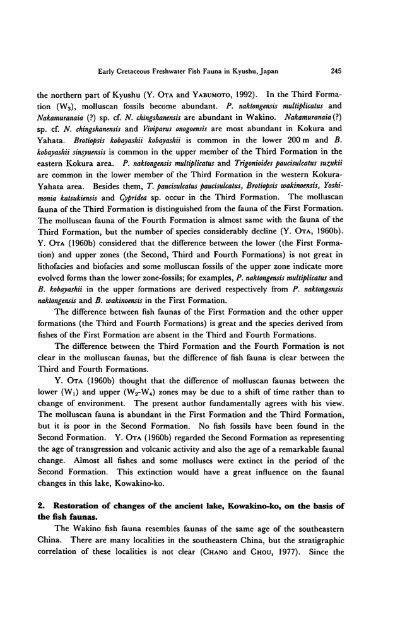Early Cretaceous Freshwater Fish Fauna in Kyushu, Japan
Early Cretaceous Freshwater Fish Fauna in Kyushu, Japan
Early Cretaceous Freshwater Fish Fauna in Kyushu, Japan
Create successful ePaper yourself
Turn your PDF publications into a flip-book with our unique Google optimized e-Paper software.
<strong>Early</strong> <strong>Cretaceous</strong> <strong>Freshwater</strong> <strong>Fish</strong> <strong>Fauna</strong> <strong>in</strong> <strong>Kyushu</strong>, <strong>Japan</strong> 245<br />
the northern part of <strong>Kyushu</strong> (Y. Ota and Yabumoto, 1992). In the Third Forma<br />
tion (W3), molluscan fossils become abundant. P. naktongensis multiplicatus and<br />
Nakamuranaia (?) sp. cf. N. ch<strong>in</strong>gshanensis are abundant <strong>in</strong> Wak<strong>in</strong>o. Nakamuranaia (?)<br />
sp. cf. N. ch<strong>in</strong>gshanensis and Viviparus onogoensis are most abundant <strong>in</strong> Kokura and<br />
Yahata. Brotiopsis kobayashii kobayashii is common <strong>in</strong> the lower 200 m and B.<br />
kobayashii s<strong>in</strong>syuensis is common <strong>in</strong> the upper member of the Third Formation <strong>in</strong> the<br />
eastern Kokura area. P. naktongensis multiplicatus and Trigonioides paucisulcatus suzukii<br />
are common <strong>in</strong> the lower member of the Third Formation <strong>in</strong> the western Kokura-<br />
Yahata area. Besides them, T. paucisulcatus paucisulcatus, Brotiopsis wak<strong>in</strong>oensis, Yoshimonia<br />
katsukiensis and Cypridea sp. occur <strong>in</strong> the Third Formation. The molluscan<br />
fauna of the Third Formation is dist<strong>in</strong>guished from the fauna of the First Formation.<br />
The molluscan fauna of the Fourth Formation is almost same with the fauna of the<br />
Third Formation, but the number of species considerably decl<strong>in</strong>e (Y. Ota, 1960b).<br />
Y. Ota (1960b) considered that the difference between the lower (the First Forma<br />
tion) and upper zones (the Second, Third and Fourth Formations) is not great <strong>in</strong><br />
lithofacies and biofacies and some molluscan fossils of the upper zone <strong>in</strong>dicate more<br />
evolved forms than the lower zone-fossils; for examples, P. naktongensis multiplicatus and<br />
B. kobayashii <strong>in</strong> the upper formations are derived respectively from P. naktongensis<br />
naktongensis and B. wak<strong>in</strong>oensis <strong>in</strong> the First Formation.<br />
The difference between fish faunas of the First Formation and the other upper<br />
formations (the Third and Fourth Formations) is great and the species derived from<br />
fishes of the First Formation are absent <strong>in</strong> the Third and Fourth Formations.<br />
The difference between the Third Formation and the Fourth Formation is not<br />
clear <strong>in</strong> the molluscan faunas, but the difference of fish fauna is clear between the<br />
Third and Fourth Formations.<br />
Y. Ota (1960b) thought that the difference of molluscan faunas between the<br />
lower (W^ and upper (W2-W4) zones may be due to a shift of time rather than to<br />
change of environment. The present author fundamentally agrees with his view.<br />
The molluscan fauna is abundant <strong>in</strong> the First Formation and the Third Formation,<br />
but it is poor <strong>in</strong> the Second Formation. No fish fossils have been found <strong>in</strong> the<br />
Second Formation. Y. Ota (1960b) regarded the Second Formation as represent<strong>in</strong>g<br />
the age of transgression and volcanic activity and also the age of a remarkable faunal<br />
change. Almost all fishes and some molluscs were ext<strong>in</strong>ct <strong>in</strong> the period of the<br />
Second Formation. This ext<strong>in</strong>ction would have a great <strong>in</strong>fluence on the faunal<br />
changes <strong>in</strong> this lake, Kowak<strong>in</strong>o-ko.<br />
2. Restoration of changes of the ancient lake, Kowak<strong>in</strong>o-ko, on the basis of<br />
the fish faunas.<br />
The Wak<strong>in</strong>o fish fauna resembles faunas of the same age of the southeastern<br />
Ch<strong>in</strong>a. There are many localities <strong>in</strong> the southeastern Ch<strong>in</strong>a, but the stratigraphic<br />
correlation of these localities is not clear (Chang and Chou, 1977). S<strong>in</strong>ce the

















